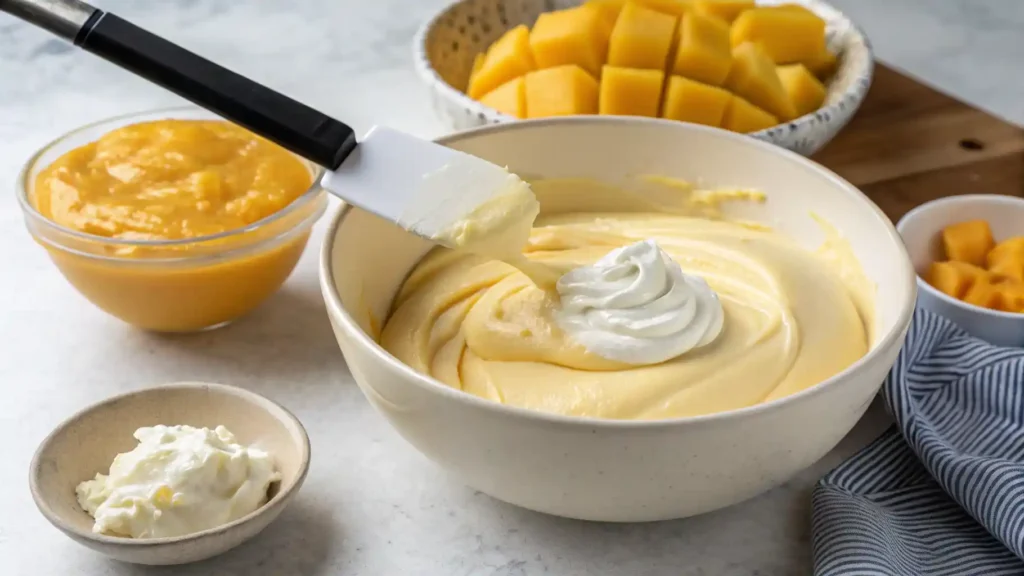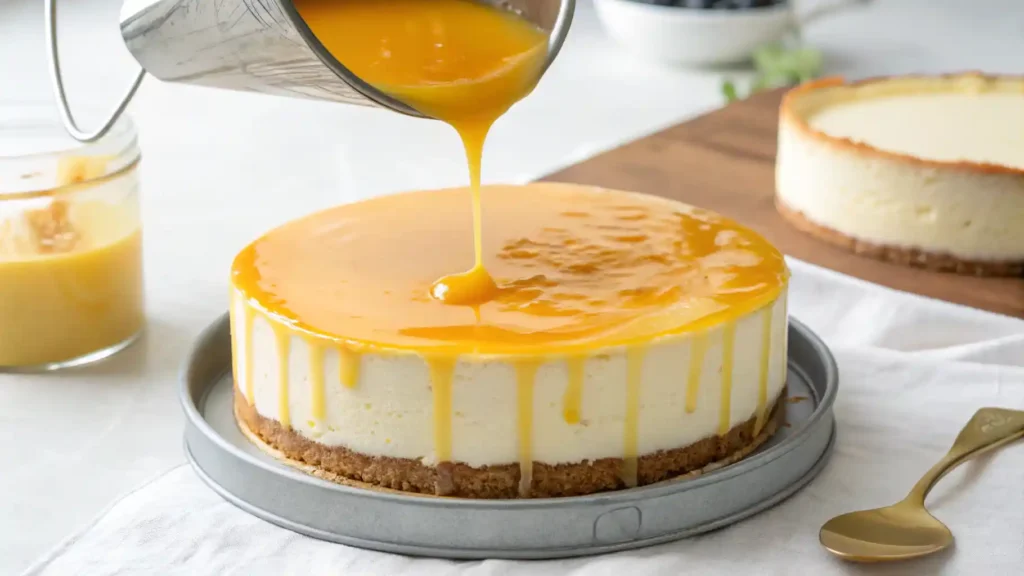If you’re looking for a dessert that’s light, luxurious, and bursting with tropical flavor, this Mango Mousse Cake is your perfect pick. With its smooth, airy mousse layered over a soft cake base and topped with vibrant mango puree, this cake is as visually stunning as it is delicious. It’s the kind of dessert that instantly elevates any occasion—from family gatherings to festive celebrations.
Unlike traditional cakes, a mousse cake offers a lighter, creamier texture that practically melts in your mouth. The luscious mango flavor brings a refreshing twist, making each bite irresistibly satisfying without being overly rich. Whether you’re a seasoned baker or trying this style for the first time, this recipe is approachable and incredibly rewarding.
What makes this Mango Mousse Cake stand out is its perfect balance—fruity, creamy, and just the right amount of sweetness. It’s a delightful fusion of textures and flavors that’s guaranteed to impress your guests and satisfy your sweet cravings. Get ready to discover how simple it is to create a show-stopping dessert right in your own kitchen.
Table of Contents
Why You’ll Love This Recipe
This Mango Mousse Cake isn’t just a treat for the taste buds—it offers several standout benefits that make it a must-try dessert for any occasion. Here’s why you’ll love making (and eating) this recipe:
1. Light and Creamy Texture
Unlike dense cakes, this mousse cake has a soft, airy texture that feels smooth and luxurious. The whipped cream and mango puree blend into a silky mousse that melts in your mouth with every bite.
2. Bursting with Fresh Mango Flavor
Fresh or canned mango puree infuses the entire cake with vibrant tropical notes. It’s fruity, refreshing, and naturally sweet—perfect for summer gatherings or when you’re craving something light.
3. Visually Stunning Dessert
The vibrant golden-yellow mousse, topped with glossy mango glaze and garnished with fresh mango slices, makes this cake an elegant centerpiece for any dessert table.
4. Easy Yet Impressive
Don’t let its elegant look fool you; this cake is surprisingly simple to bake. With simple, accessible ingredients and step-by-step guidance, even beginner bakers can pull off a professional-looking dessert.
5. Perfect Make-Ahead Option
Since this cake needs time to set in the fridge, it’s ideal for preparing a day in advance. You can enjoy a stress-free dessert on the day of your event without last-minute baking.
6. No Oven Required for Mousse Layer
Only the cake base requires baking. The mango mousse layer is a no-bake component, making this recipe a great choice for warmer days when you want to minimize oven use.
7. Customizable for Flavor Variations
You can easily tweak this recipe to include other tropical fruits like passionfruit, pineapple, or even a swirl of raspberry. The base method is flexible and forgiving.
Ingredients
This mango mousse cake consists of three main layers: a soft sponge cake base, a creamy mango mousse layer, and an optional glossy mango glaze topping. Below is the detailed list of ingredients you’ll need for each component.

For the Sponge Cake Base:
- ¾ cup (90g) all-purpose flour
- ½ teaspoon baking powder
- ¼ teaspoon salt
- 3 large eggs, room temperature
- ½ cup (100g) granulated sugar
- 1 teaspoon vanilla extract
- 2 tablespoons milk, room temperature
- 2 tablespoons melted unsalted butter
For the Mango Mousse Layer:
- 1½ cups mango puree (fresh or canned)
- 2 tablespoons granulated sugar (adjust based on mango sweetness)
- 2 teaspoons unflavored gelatin powder
- 3 tablespoons cold water (for blooming the gelatin)
- 1¼ cups heavy whipping cream, cold
- 1 teaspoon vanilla extract
Optional Mango Glaze Topping:
- ½ cup mango puree
- 1 teaspoon unflavored gelatin powder
- 2 tablespoons water
For Decoration (Optional but Recommended):
- Fresh mango slices or mango cubes
- Whipped cream swirls
- Mint leaves or edible flowers
Ingredient Notes:
- Mango Puree: You can make this by blending fresh ripe mangoes or use store-bought canned mango pulp for convenience.
- Gelatin: Unflavored gelatin helps the mousse and glaze set properly. Agar-agar can be used as a vegetarian alternative.
- Heavy Whipping Cream: Ensure it’s cold for the best volume and texture when whipped.
- Sponge Cake Alternative: If you’re short on time, a store-bought plain sponge or vanilla cake layer can be used as a substitute.
Instructions
Follow these easy step-by-step directions to make a beautifully layered mango mousse cake. This recipe includes three layers: sponge cake, mousse, and an optional glaze for a glossy finish.
Step 1: Prepare the Sponge Cake Base

- Preheat the oven to 350°F (175°C). Line the bottom of a 9-inch round cake pan with parchment paper. Do not grease the sides.
- In a mixing bowl, sift together the flour, baking powder, and salt to ensure a light and even texture.
- In another large bowl, beat the eggs and sugar using an electric mixer on high speed for about 6–8 minutes, until the mixture is pale, thick, and tripled in volume.
- Gently fold in the flour mixture in batches using a spatula. Do not overmix.
- In a small bowl, whisk together the melted butter, milk, and vanilla extract. Gradually add a few tablespoons of the cake batter to this mixture and stir gently until combined. Then fold this mixture back into the main batter.
- Pour the batter into the pan and bake for 18–22 minutes, or until a toothpick inserted in the center comes out clean.
- After baking, let the cake cool completely on a wire rack before frosting. Once cooled, trim the top if necessary to make it even.
Step 2: Make the Mango Mousse

- In a small bowl, bloom the gelatin by sprinkling it evenly over 3 tablespoons of cold water and letting it sit for a few minutes. Let it sit for 5–10 minutes.
- In a saucepan, warm the mango puree and sugar over low heat. Stir until the sugar dissolves and the mixture is warm (do not boil).
- Add the bloomed gelatin to the warm mango puree and stir until completely dissolved. Let it cool to room temperature.
- In a separate bowl, whip together the heavy cream and vanilla extract until soft peaks form.
- Once the mango mixture is cooled, gently fold the whipped cream into the mango mixture in batches until smooth and fluffy.
Step 3: Assemble the Cake
- Place the cooled sponge cake layer inside a springform pan or cake ring lined with an acetate cake collar.
- Pour the mango mousse over the sponge cake and smooth the top using a spatula.
- Before baking, gently tap the cake pan on the counter to release any trapped air bubbles in the batter.
- Refrigerate for at least 4–6 hours, or preferably overnight, until the mousse is fully set.
Step 4: (Optional) Add the Mango Glaze

- In a small bowl, bloom the gelatin in 2 tablespoons of water for 5 minutes.
- Warm the mango puree in a saucepan over low heat. Add the bloomed gelatin and stir until fully dissolved.
- Let the glaze cool slightly, then pour it over the set mousse layer.
- Chill the cake for another 1–2 hours until the glaze sets completely.
Step 5: Decorate and Serve
- Carefully remove the cake from the pan or cake ring and peel off the acetate collar.
- Decorate the top with fresh mango slices, whipped cream swirls, or mint leaves.
- Slice and serve chilled. Enjoy the light, fruity flavor with every creamy bite!
Pro Tips and Variations
Want to elevate your mango mousse cake or customize it to suit your taste or dietary needs? Here are some expert tips and creative variations that will help you get the best results every time.
Pro Tips for Perfect Results
Use Ripe Mangoes for the Best Flavor
If using fresh mangoes, choose ripe ones that are naturally sweet and aromatic. Varieties like Alphonso, Ataulfo, or Kesar work beautifully for a smooth puree.
Chill Your Mixing Bowl and Whisk
When whipping cream, use a chilled bowl and whisk for faster results and better texture. This helps achieve light, airy peaks that hold well in the mousse.
Fold Gently to Keep the Mousse Fluffy
Always fold the whipped cream into the mango mixture in small batches using a spatula. Avoid overmixing to maintain that silky, airy texture.
Set the Mousse Overnight
Though the mousse can set in 4–6 hours, allowing it to set overnight gives better structure and a cleaner cut when serving.
Line with Acetate or Parchment
Use an acetate cake collar or parchment paper inside your cake ring or springform pan for smooth, professional-looking sides.
Tap the Pan to Release Air Bubbles
Before chilling, gently tap the cake pan on the countertop to help remove trapped air bubbles that could affect the smoothness of the mousse layer.
Warm the Knife for Clean Slices
To achieve neat, clean slices without disrupting the mousse, dip your knife in hot water and wipe it dry before each cut.
Tasty Variations to Try
Mango Coconut Mousse Cake
Add ¼ cup of coconut milk to the mousse mixture and sprinkle shredded coconut over the top for a tropical twist.
Mango Raspberry Layer
Add a thin layer of raspberry puree or jam between the sponge and mousse for a tangy contrast to the sweet mango flavor.
Chocolate Sponge Base
Swap the vanilla sponge for a chocolate sponge to create a richer, decadent version of this fruity dessert.
Eggless Version
Make the sponge cake without eggs by using yogurt or buttermilk as a substitute. You can also use a store-bought eggless cake base for convenience.
No-Gelatin Option
Use agar-agar powder instead of gelatin for a vegetarian-friendly alternative. Adjust the quantity based on the brand’s instructions, as agar sets more firmly.
Mini Mango Mousse Cups
Pour the mousse into individual dessert cups or ramekins instead of assembling a full cake. This works great for parties or portion control.
Add a Crunchy Layer
Incorporate a layer of crushed biscuits or granola at the base of the cake for a lovely crunch that contrasts with the soft mousse.
Serving Suggestions
A cake as light, creamy, and vibrant as this mango mousse cake deserves to be served in a way that highlights its texture and tropical flavor. Whether you’re serving it for a special celebration or a weekend dessert, here are the best ways to enjoy and present it.
Best Ways to Serve Mango Mousse Cake
Chilled for Maximum Flavor
Always serve mango mousse cake well-chilled. The cool temperature enhances the creamy texture and allows the fruity mango notes to shine through.
With a Dollop of Whipped Cream
Add a small swirl of freshly whipped cream on top or on the side for an extra indulgent touch.
Garnish with Fresh Mango Slices
Thin slices of ripe mango make a stunning garnish. Fan them out on top of the cake for a decorative and flavorful finish.
Add a Mint Leaf or Edible Flowers
For an elegant presentation, place a few fresh mint leaves or edible flowers like pansies or violets on the cake before serving.
Drizzle with Mango or Passion Fruit Sauce
Enhance the flavor by drizzling mango puree, mango curd, or passion fruit sauce over each slice right before serving.
Pair with Ice Cream or Sorbet
Serve a slice alongside a scoop of vanilla ice cream or mango sorbet for a more decadent dessert experience.
Serve in Individual Slices or Cups
If you made a large cake, cut it into clean slices for formal plating. For parties or casual settings, consider preparing individual mousse portions in small cups or jars.
Perfect Occasions to Serve This Cake
- Summer Parties and BBQs – Refreshing and light, perfect for warm weather gatherings.
- Mother’s Day or Easter Brunch – A bright and beautiful centerpiece dessert.
- Birthday Celebrations – A fruity twist on traditional birthday cakes.
- Afternoon Tea or Coffee Time – A light treat that pairs wonderfully with hot beverages.
- Festive Holidays – Add tropical charm to your holiday dessert table.
Conclusion
If you’re looking for a dessert that’s light, creamy, and bursting with tropical flavor, this mango mousse cake is the perfect choice. It’s elegant enough to impress guests at special occasions, yet simple enough to enjoy any time you’re craving something sweet and fruity.
From the smooth mango mousse to the soft sponge cake base, every layer offers a delightful balance of taste and texture. Whether you’re a seasoned baker or just starting out, this recipe is straightforward, rewarding, and sure to become a favorite in your kitchen.
This cake’s versatility is what makes it special. You can serve it at summer parties, holiday gatherings, or even as a refreshing treat on a quiet weekend. Plus, the bright, sunny mango flavor paired with the creamy mousse makes it a dessert people won’t forget.
Now it’s your turn! Gather your ingredients, bake this irresistibly creamy mango mousse cake, and savor every delicious bite. Once you taste it, you’ll be looking for excuses to make it again.
FAQs
1. What does mango mousse cake taste like?
Mango mousse cake has a smooth, creamy texture with a sweet and slightly tangy mango flavor. The light mousse and soft sponge base create a refreshing and fruity dessert experience.
2. What is the difference between mousse cake and normal cake?
Mousse cake typically has a light, airy filling made with whipped cream or gelatin, giving it a fluffy, melt-in-your-mouth texture. In contrast, a regular cake has a denser structure and is often layered with frosting or buttercream.
3. What does mousse mean in cake?
Mousse refers to a creamy, whipped filling made with ingredients like cream, fruit puree, and gelatin. In mousse cakes, this filling forms the main layer, giving the dessert a delicate and silky texture.
4. How long does mango mousse take to set?
Mango mousse generally takes about 4 to 6 hours to set properly in the refrigerator. For the best results and firmness, let the cake chill overnight.
5. How long does mousse cake last in the fridge?
Mousse cake can be stored in the refrigerator for up to 3 to 4 days. Keep it covered or in an airtight container to maintain freshness and prevent it from drying out.
6. Is mousse just whipped cream?
Not exactly. While whipped cream is a key ingredient, mousse also contains fruit puree, chocolate, or gelatin to give it structure and flavor. The combination creates a more stable and flavorful texture than whipped cream alone.
7. What goes well with mousse?
Mousse pairs well with a variety of elements like sponge cake, chocolate shavings, fresh berries, fruit sauces, and nuts. These add texture and contrast to the creamy base.
8. What to pair with mango mousse?
Fresh fruits like raspberries, strawberries, or kiwi make excellent pairings. You can also serve it with a drizzle of mango coulis, a sprinkle of toasted coconut, or a dollop of whipped cream for extra flair.


